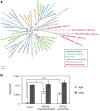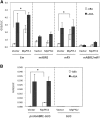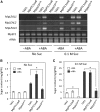Archetypal Roles of an Abscisic Acid Receptor in Drought and Sugar Responses in Liverworts
- PMID: 30442644
- PMCID: PMC6324230
- DOI: 10.1104/pp.18.00761
Archetypal Roles of an Abscisic Acid Receptor in Drought and Sugar Responses in Liverworts
Abstract
Abscisic acid (ABA) controls seed dormancy and stomatal closure through binding to the intracellular receptor Pyrabactin resistance1 (Pyr1)/Pyr1-like/regulatory components of ABA receptors (PYR/PYL/RCAR) in angiosperms. Genes encoding PYR/PYL/RCAR are thought to have arisen in the ancestor of embryophytes, but the roles of the genes in nonvascular plants have not been determined. In the liverwort Marchantia polymorpha, ABA reduces growth and enhances desiccation tolerance through increasing accumulation of intracellular sugars and various transcripts such as those of Late Embryogenesis Abundant (LEA)-like genes. In this study, we analyzed a gene designated MpPYL1, which is closely related to PYR/PYL/RCAR of angiosperms, in transgenic liverworts. Transgenic lines overexpressing MpPYL1-GFP showed ABA-hypersensitive growth with enhanced desiccation tolerance, whereas Mppyl1 generated by CRISPR-Cas9-mediated genome editing showed ABA-insensitive growth with reduced desiccation tolerance. Transcriptome analysis indicated that MpPYL1 is a major regulator of abiotic stress-associated genes, including all 35 ABA-induced LEA-like genes. Furthermore, these transgenic plants showed altered responses to extracellular Suc, suggesting that ABA and PYR/PYL/RCAR function in sugar responses. The results presented here reveal an important role of PYR/PYL/RCAR in the ABA response, which was likely acquired in the common ancestor of land plants. The results also indicate the archetypal role of ABA and its receptor in sugar response and accumulation processes for vegetative desiccation tolerance in bryophytes.
© 2019 American Society of Plant Biologists. All Rights Reserved.
Figures









Similar articles
-
Contrasting transcriptional responses of PYR1/PYL/RCAR ABA receptors to ABA or dehydration stress between maize seedling leaves and roots.BMC Plant Biol. 2016 Apr 21;16:99. doi: 10.1186/s12870-016-0764-x. BMC Plant Biol. 2016. PMID: 27101806 Free PMC article.
-
Overexpression of Poplar Pyrabactin Resistance-Like Abscisic Acid Receptors Promotes Abscisic Acid Sensitivity and Drought Resistance in Transgenic Arabidopsis.PLoS One. 2016 Dec 19;11(12):e0168040. doi: 10.1371/journal.pone.0168040. eCollection 2016. PLoS One. 2016. PMID: 27992471 Free PMC article.
-
Abscisic acid-induced rearrangement of intracellular structures associated with freezing and desiccation stress tolerance in the liverwort Marchantia polymorpha.J Plant Physiol. 2014 Sep 15;171(15):1334-43. doi: 10.1016/j.jplph.2014.05.004. Epub 2014 Jun 6. J Plant Physiol. 2014. PMID: 25046754
-
[ABA signaling mediated by PYR/PYL/RCAR in plants].Yi Chuan. 2012 May;34(5):560-72. doi: 10.3724/sp.j.1005.2012.00560. Yi Chuan. 2012. PMID: 22659428 Review. Chinese.
-
PYR/PYL/RCAR Receptors Play a Vital Role in the Abscisic-Acid-Dependent Responses of Plants to External or Internal Stimuli.Cells. 2022 Apr 15;11(8):1352. doi: 10.3390/cells11081352. Cells. 2022. PMID: 35456031 Free PMC article. Review.
Cited by
-
Differential regulations of abscisic acid-induced desiccation tolerance and vegetative dormancy by group B3 Raf kinases in liverworts.Front Plant Sci. 2022 Jul 28;13:952820. doi: 10.3389/fpls.2022.952820. eCollection 2022. Front Plant Sci. 2022. PMID: 35968153 Free PMC article.
-
Signaling mechanisms in abscisic acid-mediated stomatal closure.Plant J. 2021 Jan;105(2):307-321. doi: 10.1111/tpj.15067. Epub 2020 Dec 9. Plant J. 2021. PMID: 33145840 Free PMC article. Review.
-
Environmental gradients reveal stress hubs pre-dating plant terrestrialization.Nat Plants. 2023 Sep;9(9):1419-1438. doi: 10.1038/s41477-023-01491-0. Epub 2023 Aug 28. Nat Plants. 2023. PMID: 37640935 Free PMC article.
-
Environmental Pollutant Anthracene Induces ABA-Dependent Transgenerational Effects on Gemmae Dormancy in Marchantia polymorpha.Plants (Basel). 2024 Oct 25;13(21):2979. doi: 10.3390/plants13212979. Plants (Basel). 2024. PMID: 39519898 Free PMC article.
-
Activation of SnRK2 by Raf-like kinase ARK represents a primary mechanism of ABA and abiotic stress responses.Plant Physiol. 2021 Mar 15;185(2):533-546. doi: 10.1093/plphys/kiaa046. Plant Physiol. 2021. PMID: 33655297 Free PMC article.
References
-
- Akter K, Kato M, Sato Y, Kaneko Y, Takezawa D (2014) Abscisic acid-induced rearrangement of intracellular structures associated with freezing and desiccation stress tolerance in the liverwort Marchantia polymorpha. J Plant Physiol 171: 1334–1343 - PubMed
-
- Althoff F, Kopischke S, Zobell O, Ide K, Ishizaki K, Kohchi T, Zachgo S (2014) Comparison of the MpEF1α and CaMV35 promoters for application in Marchantia polymorpha overexpression studies. Transgenic Res 23: 235–244 - PubMed
-
- Bowman JL, Kohchi T, Yamato KT, Jenkins J, Shu S, Ishizaki K, Yamaoka S, Nishihama R, Nakamura Y, Berger F, et al. (2017) Insights into land plant evolution garnered from the Marchantia polymorpha genome. Cell 171: 287–304.e15 - PubMed
Publication types
MeSH terms
Substances
LinkOut - more resources
Full Text Sources

